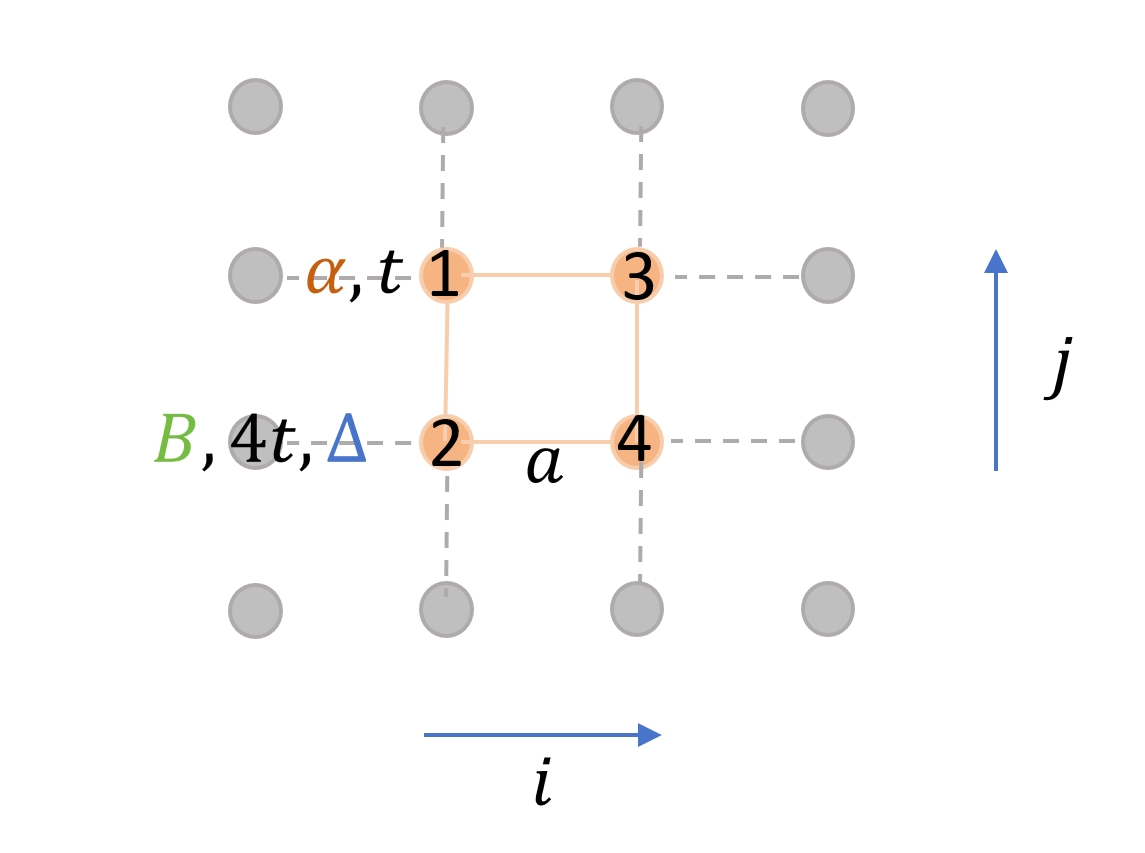BdG Equation in different spaces
X.-Z. CHEN, 17/05/2024, EIT, Ningbo
1. BdG Eq. in type1-Nambu space
Let us consider a two-dimensional electron system with Rashba spin-orbit-coupling (SOC), Dresselhaus SOC, spatialy-varying magnetic texture and proximity-induced superconductivity. The time-independent Schrodinger
describing such an electron is written in real space as
where $\hat{\Psi}(\vec{r})=( c_{\uparrow,\vec{r}},c_{\downarrow,\vec{r}},c_{\uparrow,\vec{r}}^{\dagger},c_{\downarrow,\vec{r}}^{\dagger})^{T}$ is the wavefunction in particle-hole and spin spaces, $\Delta$ is the superconductor order parameter, $E$ are the energy eigenvalues and
where $\vec{J}(\vec{r}) \cdot \vec{\sigma}=J_x\sigma_x + J_y\sigma_y + J_z\sigma_z$,
$\vec{p}=(p_x,p_y,p_z)$ are the momentum operators, with $p_{i}=-i\hbar\partial_{i}$ ($i=x,y,z$), $m$ is the effective mass of electron, $\mu$ is the chemical potential, $\alpha$ is the strength of Rashba SOC, $\gamma$ is the strength of Dresselhaus SOC, $\vec{J}(\vec{r})$ describes the effective exchange field at position $\vec{r}$, $\vec{\sigma}=(\sigma_x,\sigma_y,\sigma_z)$ are the Pauli
spin matricies, and $\sigma_0$ is the $2\times 2$ unit matrix.
so we get
For the one-dimensional case, and ingore the z-component of $\vec{J}$ and Dresselhaus SOC, we get
1.1 $s$-wave and $p$-wave pair
1.1.1 $s$-wave 1d BdG equation
$s$-wave S.C. with a constant pairing $\Delta(\vec{k})=\Delta_s$
which correspond the Hamiltonian given in arXiv:2311.09009.
s-wave Josephson junction in convention space
Left S.C.
Right S.C. with phase $\phi$ arXiv:2311.09009,
1.1.2 $p$-wave 1d BdG equation
$p$-wave S.C. with a time-reversal broken p-wave S.C. with $\Delta(\vec{k})=\Delta_p(p_x-ip_y)$ [Ramon:review Eq.46, 2024-PRL-Strkalj]
p-wave Josephson junction in convention space
Left S.C.
Right S.C.
Note that, the Hermitian conjugate (h.c.) seems not work on the $p_x$?
2. BdG Eq. in type2-Nambu space
Same as the Eq. (1) setting but for Nambu space. The Hamiltonian read as
where $\hat{\Psi}(\vec{r})=(c_{\uparrow,\vec{r}},c_{\downarrow,\vec{r}},-c_{\downarrow,\vec{r}}^{\dagger},c_{\uparrow,\vec{r}}^{\dagger})^{T}$ is the wavefunction in Nambu spaces. Here, we first show the common used for calculation,
Combined with Eq. \eqref{ham_conj}, we can get
so we get
For the one-dimensional case, and ignore the z-component of $\vec{J}$ and Dresselhaus SOC, we get
2.1 $s$-wave and $p$-wave pair
2.1.1 $s$-wave 1d BdG equation
$s$-wave S.C. with a constant pairing $\Delta(\vec{r})=\Delta$
$s$-wave Josephson junction in Nambu spaces
Left S.C.
Right S.C. with phase $\phi$
2.1.2 $p$-wave 1d BdG equation
$p$-wave S.C. $\Delta(\vec{r})=\Delta_p (p_x-ip_y)$
$p$-wave Josephson junction in Nambu spaces
Left S.C.
Right S.C. with phase $\phi$
3. Further related reading
When we solve BdG equation, we always find some Nambu spaces which just slightly different from the standard one $\hat{\Psi}(\vec{r})=(c_{\uparrow,\vec{r}},c_{\downarrow,\vec{r}},-c_{\downarrow,\vec{r}}^{\dagger},c_{\uparrow,\vec{r}}^{\dagger})^{T}$, i.e. the Nambu space used in Fu’s paper[2008-Fu-PRL] is $\hat{\Psi}(\vec{r})=(c_{\uparrow,\vec{r}},c_{\downarrow,\vec{r}},c_{\downarrow,\vec{r}}^{\dagger},-c_{\uparrow,\vec{r}}^{\dagger})^{T}$, an important question is how to solve the BdG equation in this new Nambu space? The following article answer this question.
W. Tu, X.-Z. CHEN, BdG in slightly different Nambu space
If you want to go further about this topic, please check the document: XC_BdG_diffspaces

